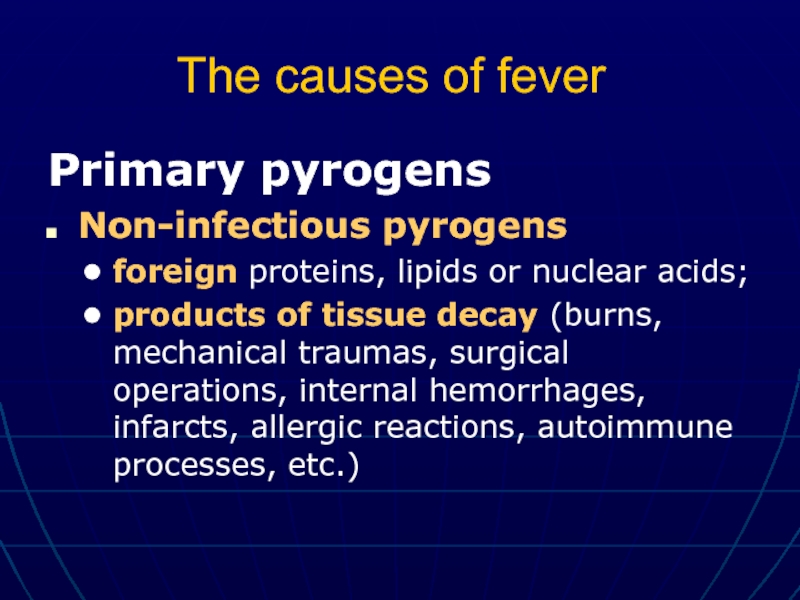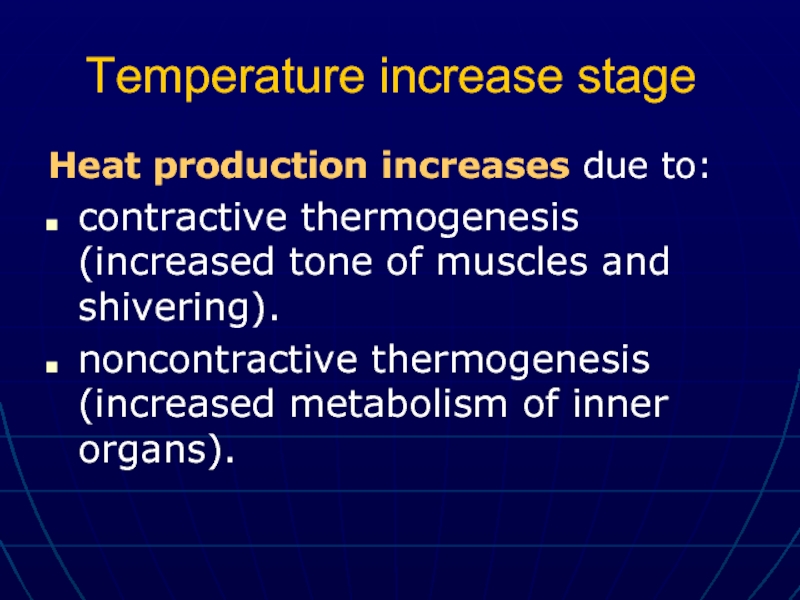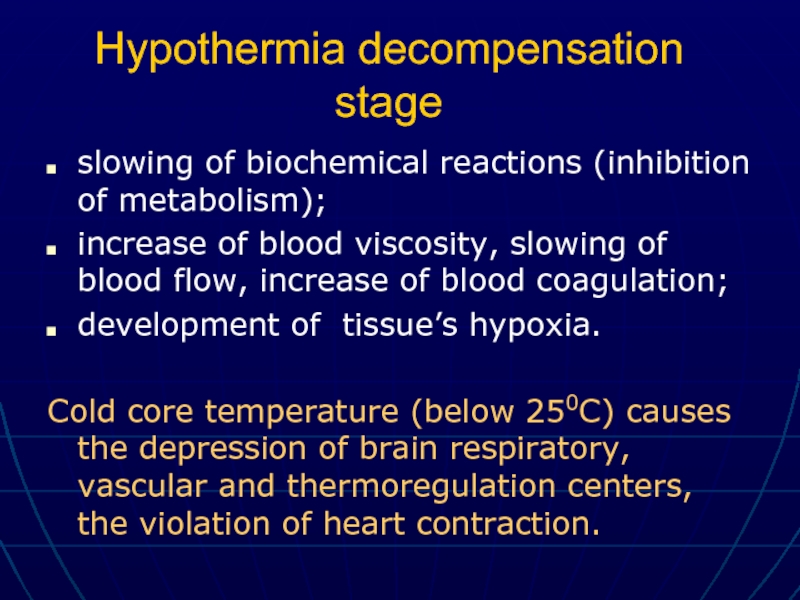- Главная
- Разное
- Дизайн
- Бизнес и предпринимательство
- Аналитика
- Образование
- Развлечения
- Красота и здоровье
- Финансы
- Государство
- Путешествия
- Спорт
- Недвижимость
- Армия
- Графика
- Культурология
- Еда и кулинария
- Лингвистика
- Английский язык
- Астрономия
- Алгебра
- Биология
- География
- Детские презентации
- Информатика
- История
- Литература
- Маркетинг
- Математика
- Медицина
- Менеджмент
- Музыка
- МХК
- Немецкий язык
- ОБЖ
- Обществознание
- Окружающий мир
- Педагогика
- Русский язык
- Технология
- Физика
- Философия
- Химия
- Шаблоны, картинки для презентаций
- Экология
- Экономика
- Юриспруденция
Thermoregulation pathology. (Lecture 6) презентация
Содержание
- 1. Thermoregulation pathology. (Lecture 6)
- 2. Human thermoregulation
- 3. The sources of heat production Body
- 4. The ways of heat loss Heat conduction
- 5. Thermoregulation mechanisms
- 6. The causes of fever Primary pyrogens Infectious
- 7. The causes of fever Primary pyrogens Non-infectious
- 8. The causes of fever Secondary pyrogens
- 9. Fever stages Temperature increase stage
- 10. Temperature increase stage Secondary
- 11. Heat loss decreases due to: skin periphery
- 12. Temperature increase stage Peripheral
- 13. Temperature increase stage Heat production increases due
- 14. High temperature standing stage no further
- 15. The types of temperature curves Febris continua
- 16. The level of temperarure increase Subfebrile temperature
- 17. Temperature descent stage Decrease of pyrogenic
- 18. Metabolic changes in fever BMR in the
- 19. Metabolic changes in fever Water metabolism 1st
- 20. Changes in organs function in fever Nervous
- 21. Changes in organs function in fever GIT
- 22. The role of fever POSITIVE
- 23. The causes of hyperthermia Exogenous – hot
- 24. The causes of hyperthermia Endogenous increase of
- 25. Hyperthermia compensation stage Increase of heat loss
- 26. Changes in the organism due to body’s
- 27. Hyperthermia decompensation stage cardiovascular disturbances – progressive
- 28. The biochemical effects of long exposure to
- 29. The biochemical effects of long exposure to
- 30. Heat stroke manifestation Body temperature >40 C
- 31. Thermotherapy (pyrotherapy) General thermotherapy - injection
- 32. Thermotherapy (pyrotherapy) Local thermotherapy may be used
- 33. Differences between fever and hyperthermia
- 34. Differences between fever and hyperthermia
- 35. When fever treatment is needed when fever
- 36. The causes of hypothermia not effective thermoregulation
- 37. Hypothermia compensation stage Behavioral thermoregulation Reduction
- 38. Changes in the organism due to body’s
- 39. Hypothermia decompensation stage slowing of biochemical reactions
- 40. Vicious circles during hypothermia Low body
- 41. Vicious circles during hypothermia Low body
- 42. Vicious circles during hypothermia Low
- 43. Controlled hypothermia Systemic controlled hypothermia is
- 44. The prospects of using medical hibernation
Слайд 3The sources of heat production
Body BMR (Basal Metabolic Rate)
Increased Metabolic
muscle activity (shivering);
effect of thyroxin on the cells;
effects of epinephrine, norepinephrine and sympathetic stimulation on the cells.
Слайд 4The ways of heat loss
Heat conduction to the objects
Heat conduction to
Heat irradiation.
Evaporation.
Слайд 6The causes of fever
Primary pyrogens
Infectious pyrogens (from bacteria, viruses, protozoa, fungi).
polysaccharides and lipopolysaccharides of the microbial cell membrane.
Слайд 7The causes of fever
Primary pyrogens
Non-infectious pyrogens
foreign proteins, lipids or nuclear acids;
products
Слайд 8The causes of fever
Secondary pyrogens
cytokines: IL-1, IL-6, TNF, gamma-interpherone (produced
Pyrogenic cytokines are synthesized in every case of primary pyrogens appearance.
Слайд 9Fever stages
Temperature increase stage – stadium incrementi
High
Temperature descent stage -stadium decrementi
Слайд 10
Temperature increase stage
Secondary
pyrogens
Thermoregulatory neurons
Activation of phospholipase
Increased AA metabolism
Increased PG E2
Accumulation of cAMP
Decrease of
cold neurons
excitation
threshold
Adjusting point
of thermoregulation
becomes higher
Primary
pyrogens
Слайд 11Heat loss decreases due to:
skin periphery vessels constriction
sweat secretion inhibition
decrease of
pilomotor reflex - “goose-flesh”
Temperature increase stage
Слайд 12
Temperature increase stage
Peripheral vessels
constriction
shivering,
pilomotor reflex,
feeling of cold
Irritation of skin
cold
thermoregulation
center
excitation
Activation of heat
production
RIGOR
Слайд 13Temperature increase stage
Heat production increases due to:
contractive thermogenesis (increased tone of
noncontractive thermogenesis (increased metabolism of inner organs).
Слайд 14High temperature standing stage
no further temperature increase
heat loss increases
thermoregulation is normal (heat production and heat loss are in normal balance)
Слайд 15The types of temperature curves
Febris continua - temperature fluctuation within 1
Febris remittens - daily fluctuation exceeds the 1 C0 range, temperature is high (exudative pleuritis).
Febris intermittens - daily fluctuation exceeds the 1 C0 range, temperature may reverse to normal (malaria, infectious endocarditis).
Febris hectica - temperature fluctuation is 3 to 5 degrees (sepsis)
Слайд 16The level of temperarure increase
Subfebrile temperature up to 38 C
Febrile
Pyretic temperature –39 - 41C
Hyperpyretic – temperature is higher than 41C
Слайд 17Temperature descent stage
Decrease of pyrogenic cytokines synthesis
Adjusting point of
Heat loss is prevailing
The decrease of fever may be lytical (slow) or critical (fast).
Слайд 18Metabolic changes in fever
BMR in the 1st and 2nd fever stage
Carbohydrate and lipids metabolism – prevalence of catabolic processes in the 1st and 2nd fever stage. In the 3rd stage – normal.
Protein metabolism is disturbed in the case of long lasting fever – proteolysis will increase.
Слайд 19Metabolic changes in fever
Water metabolism
1st stage – increased water loss (due
2nd stage - accumulation of water in the organism.
3rd stage - increased water loss (increase of diuresis and sweating)
Слайд 20Changes in organs function in fever
Nervous system – insomnia, high irritability,
Endocrine system – increase of ACTH, catecholamines, TSH, thyroid hormones.
Heart – tachycardia.
Lungs – increased alveolar ventilation and gas diffusion.
Слайд 21Changes in organs function in fever
GIT - loss of appetite, decrease
Liver and pancreas - decreased synthesis of digestive enzymes.
Kidneys – increased diuresis in the 1 and 3 stage of fever and accumulation of water in the second stage.
Слайд 22The role of fever
POSITIVE
Bacteriostatic and bactericidal effects on microbes
Activation
Increased liver function (detoxication, protein and vitamins synthesis)
Active excretion of toxins (due to increased sweating and diuresis).
NEGATIVE
Functional overload of organs (lungs, heart, endocrine glands)
Hypohydration (cholera) and blood hemolysis (malaria) may lead to disturbances of blood clotting
Disturbances of GIT function due to increased level of toxic substances
Слайд 23The causes of hyperthermia
Exogenous – hot climate, hot workshops, heat-isolated cloth,
Endogenous disturbances of heat regulation, without pyrogens formation
heat regulation center violations (cerebral traumas, encephalitis, cerebral edema)
fever caused by psychical diseases, nervous excitation, stresses
Слайд 24The causes of hyperthermia
Endogenous increase of heat production
intensive muscular loading
pathologic
disconnection of oxidation and phosphorylation processes which increases heat production (poisoning by 2,4-dinitrophenolum, hyperthyroidism).
Endogenous decrease of heat loss
sweat secretion decrease under poisoning by cholinolytic medicines (Atropinum);
skin vessels spasms (adrenimimetic overdose and adrenali increased rejection).
Слайд 25Hyperthermia compensation stage
Increase of heat loss –dilating of skin arterioles, increase
Changes in organism’s functions:
increase of heart rate and BP;
centralization of bloodflow;
decrease of alveolar ventilation;
decrease of working capacity, weakness, drowse, high irritability.
Слайд 26Changes in the organism due to body’s temperature
38°C - Sweating.
39°C - Severe sweating, redness of the skin, fast heart rate and breathlessness.
40°C - + Fainting, dehydration, weakness, vomiting, headache and dizziness, profuse sweating.
41°C - + hallucinations, delirium, drowsiness.
42°C - + severe delirium and vomiting, coma, convulsions.
43°C - + serious brain damage, continuous convulsions and shock, cardio-respiratory collapse will occur.
44°C or more - almost certainly death will occur.
Compensation
Decompensation
Слайд 27Hyperthermia decompensation stage
cardiovascular disturbances – progressive tachycardia, decrease of heart stroke
acidosis due to hypoxia.
hypohydration (du to profound sweating) leads to increased blood viscosity
metabolic violations
Слайд 28The biochemical effects of long exposure to high temperature
Denaturation of proteins
Liquefaction of lipid membrane – destroying cell walls
Damage of mitochondrial membranes - paralysis of energy production
Increase of Na+ leak
Слайд 29The biochemical effects of long exposure to high temperature
Increase of peroxidative
Carbohydrate metabolism and other energy pathways are disrupted.
The loss of energy in the cell reduces normal cellular functions and thermoregulation fails.
Слайд 30Heat stroke manifestation
Body temperature >40 C
CNS depression (the most important
bizarre behavior
amnesia
collapse, delirium, stupor, and coma.
The skin color may be ashen, implying circulatory collapse, or pink.
Symptoms of autonomic nervous system dysfunction, miosis, decreased pain response, and dehydration symptoms
Слайд 31Thermotherapy (pyrotherapy)
General thermotherapy - injection of bacterial lipopolysaccride (primary pyrogens).
Aims:
to increase adaptive and innate immunity in chronic infectious diseases (arthritis, syphilis)
to intensify reparative processes in bones and other tissues after their damage, trauma, surgical operations.
Слайд 32Thermotherapy (pyrotherapy)
Local thermotherapy may be used in cancer treatment:
tumor cells have
local increase of temperature brake mitoses in cancer cells, cause denaturation of cancer cell membrane proteins.
Even if the cancerous cells do not die, they become more susceptible to ionizing radiation treatments or to certain chemotherapies.
Слайд 35When fever treatment is needed
when fever is accompanied with high pyretic
when fever is observed in the patient with cardio-vascular failure, diabetes mellitus or other endocrine diseases;
in newborns (0-2 months), infants (2 months till 1 year) and aged people.
Слайд 36The causes of hypothermia
not effective thermoregulation (infants, babies and aged people);
too
disturbances of nervous system function (drugs, alcohol, toxic substances, parkinson disease);
disturbances of endocrine system function (hypothyroidism, hypopituitarism, adrenal insufficiency) that lead to decreased heat production.
Слайд 37Hypothermia compensation stage
Behavioral thermoregulation
Reduction of heat loss - peripheral blood
Increase of heat production - activation of bloodflow in inner organs, induction of contractive thermogenesis (shivering).
Heart and lungs: tachycardia, increase of BP and heart stroke volume, increased ventilation of lungs.
Слайд 38Changes in the organism due to body’s temperature
35°C - Intense shivering,
34°C - Severe shivering, loss of movement of fingers, blueness and confusion.
33°C + sleepiness, depressed reflexes, progressive loss of shivering, slow heart beat, shallow breathing.
32°C + Hallucinations, delirium, comatose. Shivering and nervous reflexes are absent.
31°C + shallow breathing and slow heart rate. Possibility of serious heart rhythm problems.
28°C + Severe heart rhythm disturbances, problems with breathing.
24-26°C or less - Death due to irregular heart beat or respiratory arrest.
Compensation
Decompensation
Слайд 39Hypothermia decompensation stage
slowing of biochemical reactions (inhibition of metabolism);
increase of blood
development of tissue’s hypoxia.
Cold core temperature (below 250C) causes the depression of brain respiratory, vascular and thermoregulation centers, the violation of heart contraction.
Слайд 40Vicious circles during hypothermia
Low
body temperature
Metabolic circle
Metabolism
inhibition
Low
heat production
Слайд 41Vicious circles during hypothermia
Low
body temperature
Vascular circle
Dilation of
peripheral
vessels
Increased
heat loss
Слайд 42
Vicious circles during hypothermia
Low
body temperature
Neuro-muscular circle
Decreased excitability
of nervous centres
Absence of
thermogenesis
Слайд 43Controlled hypothermia
Systemic controlled hypothermia is used in surgical operations on
Cells and tissues in the controlled hypothermia decrease their functional activity.
It prevents disturbances of ABB, water and ion metabolism, increase tissue’s resistance to hypoxia and other pathogenic stimuli.
Local induced hypothermia (brain, kidneys, liver, prostate etc.) is provided complex surgical operations.
Слайд 44The prospects of using medical hibernation
Organ preservation (for transplantation).
Strokes treatment
Trauma (decrease of body's oxygen demand to survive bleedings).

















































